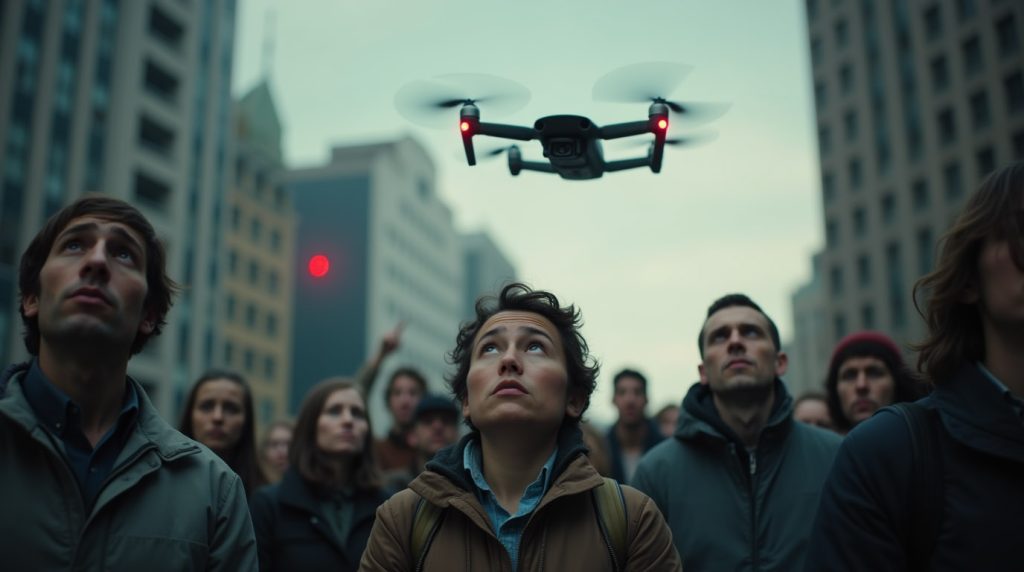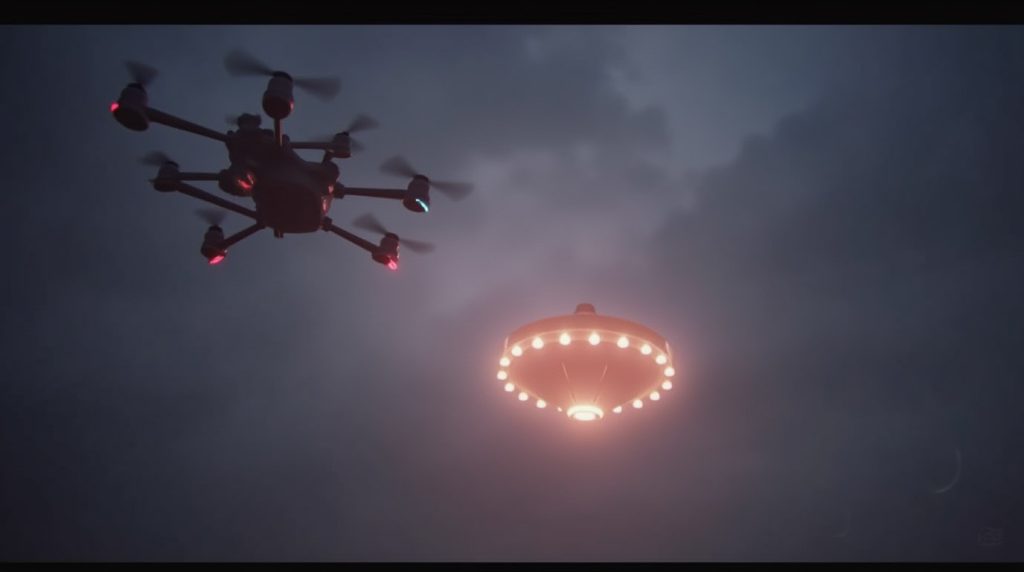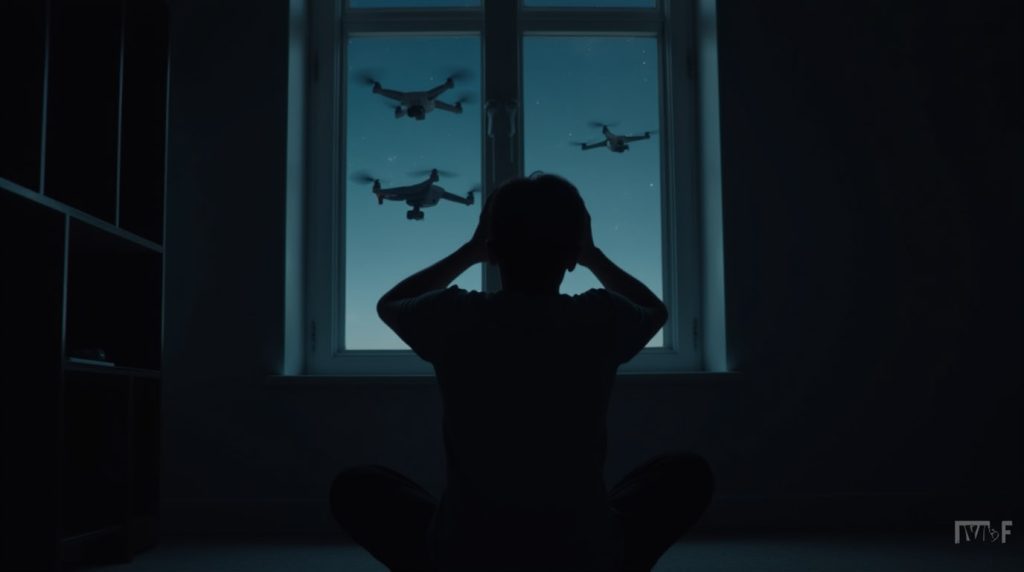Few people know me well, but for those that do, they know that I relish in picking through news stories and mainstream media events, to discover the methods they are using to train the readers mind to accept the story / narrative being told or shown to them. I saw it happen in real-time throughout the CV19 Pandemic global response, and so the most recent ‘Drone’ footage appearing worldwide has peaked my interest…. please read on (or you can listen to this podcast interview based on this post).
In the past few years, an unsettling trend has emerged: mysterious drone formations appearing over major cities, government disclosures about UFOs, and growing suspicions of psychological operations (PsyOps). These events have not only captivated public attention but have also ignited a collective sense of anxiety. The convergence of these phenomena—drones, unidentified aerial phenomena (UAPs), and persistent media narratives—has created a perfect storm of uncertainty.
This blog post explores the roots of this anxiety. It examines how mysterious drone sightings, fears of extraterrestrial life, and theories of government manipulation are shaping public perceptions. We’ll also delve into how media language amplifies these fears and discuss ways to address the growing emotional toll this “age of the unknown” is taking on society.
The Drones in Our Skies: A Catalyst for Anxiety

Unprecedented Sightings Around the World
Over the past few years, people in cities like New York, London, Tokyo, and Sydney have reported seeing drones flying in strange, synchronized formations. Unlike hobbyist drones or commercial delivery vehicles, these unidentified drones display characteristics that defy conventional understanding. Witnesses describe silent operation, advanced maneuverability, and unmarked designs that make their origins impossible to trace.
These sightings, while fascinating, are inherently unsettling for several reasons:
1. They Suggest Surveillance: The idea of untraceable drones watching over populated areas triggers fears of mass surveillance. Who is controlling these drones, and for what purpose? The lack of answers breeds paranoia.
2. They Seem Advanced Beyond Known Technology: Many sightings describe drones performing maneuvers that current technology cannot replicate. This has led to speculation about secret military programs, extraterrestrial technology, or even a combination of the two.

3. They Emerge Without Warning: The sporadic nature of these drone appearances—sometimes disappearing as quickly as they arrive—creates a sense of unpredictability. Humans are hardwired to fear the unpredictable, as it signals a lack of control.
The Link to UFOs and UAPs
Adding to the unease is the fact that these drone sightings coincide with a growing global conversation about UFOs. In recent years, governments have begun to disclose previously classified information about UAPs. The U.S. Department of Defense, for example, has released footage of unidentified objects performing feats beyond known human capabilities.
For many, the link between these disclosures and the mysterious drones is clear: Are these drones a precursor to full-scale contact with extraterrestrial life? Or are they part of humanity’s attempt to reverse-engineer alien technology? These questions stoke existential fears, forcing people to grapple with the possibility that life as we know it could change forever.

The Role of Media in Amplifying Anxiety
The Power of Repetition and Emotional Language
Mainstream media plays a significant role in shaping public perceptions about drones, UFOs, and government secrecy. News headlines often use emotionally charged words like “mysterious,” “unexplained,” and “threat” to describe these events. This language triggers fear responses, especially when repeated across multiple outlets.
For example, reports on drone sightings frequently emphasize secrecy and danger. By repeating terms that evoke uncertainty, the media primes the public to view these events as threatening. This repetition creates a feedback loop: The more people hear about the “mystery” of drones, the more anxious they become.

Framing the Unknown as a Crisis
News stories about drones and UFOs often frame these phenomena as unsolved mysteries or crises. This framing encourages speculation and worry. Instead of presenting these events as neutral or benign, the media amplifies their potential to disrupt normal life. The result? A population on edge, unsure whether to expect alien invasions, government surveillance, or something even more sinister.
Government Psychological Operations: The Anxiety Behind the Curtain
The Rise of PsyOps Theories
Theories about government psychological operations, or PsyOps, have gained traction as anxiety about drones and UFOs grows. PsyOps refer to strategic efforts to influence public perception and behavior, often by manipulating emotions like fear or curiosity.
Some theorists argue that these drone sightings and UFO disclosures are deliberate PsyOps designed to achieve specific goals:
1. Distraction: By focusing public attention on mysterious aerial phenomena, governments may divert scrutiny from more pressing issues, such as economic instability or political corruption.
2. Control Through Fear: Fear is a powerful tool for controlling populations. By keeping people worried about the unknown—whether it’s aliens, surveillance, or advanced technology—governments can justify increased military budgets, surveillance measures, or emergency powers.
3. Gradual Disclosure: Some believe these events are part of a slow, calculated process to prepare humanity for the eventual revelation of extraterrestrial life. If true, this raises questions about what governments know and why they’re withholding the full truth.

Chase Hughes on Media and PsyOps
Chase Hughes, an expert in behavioral analysis and government PsyOps, explains how repetitive media narratives can shape public opinion and amplify anxiety. In a YouTube video, Hughes identifies several techniques used by governments and media to influence the masses:
– Repetition of Key Phrases: Words like “unidentified,” “alien,” and “potential threat” are repeated in news coverage to anchor those ideas in the public consciousness.
– Emotionally Loaded Language: Sensational terms like “invasion” or “unexplainable” evoke fear and confusion, making people more susceptible to manipulation.
– Framing for Impact: By presenting these phenomena as crises, media outlets create a sense of urgency that drives public engagement but also heightens anxiety.
These techniques are not accidental. They are designed to capture attention and influence behavior, often at the expense of public peace of mind.
The Emotional Toll of the Unknown
Why Uncertainty Breeds Anxiety
At its core, anxiety is a response to uncertainty. When people cannot predict or control their environment, their brains go into overdrive, searching for answers. The mysterious nature of these drone sightings and UFO disclosures feeds into this natural tendency. Without clear explanations, our minds fill in the blanks—often with worst-case scenarios.

The Collective Impact on Society
The constant exposure to mystery and fear takes a toll on mental health. People feel powerless in the face of the unknown, leading to widespread feelings of unease. Social media amplifies this effect, as stories and theories about drones, aliens, and government PsyOps spread like wildfire.
This collective anxiety can manifest in various ways:
– Paranoia: People may begin to see surveillance or manipulation where none exists.
– Distrust of Authority: Government secrecy fuels suspicion, making it harder for people to trust official explanations.
– Existential Fear: The idea of extraterrestrial life or advanced technology challenges our understanding of reality, creating fear of the unknown.
How to Address This Growing Anxiety
Critical Thinking and Media Literacy
One of the most effective ways to combat anxiety is to question the narratives we encounter. Chase Hughes emphasizes the importance of critical thinking in resisting manipulation. By asking questions like “Who benefits from this story?” or “What evidence supports this claim?” we can begin to separate fact from fiction.
Diversify Information Sources
Relying on a single news outlet can skew perception. Exploring multiple perspectives, including independent or international media, provides a more balanced view of events.
Focus on What’s Known
Speculating about aliens or government conspiracies can be mentally exhausting. Instead, focus on the verifiable aspects of these events, such as the technological capabilities of drones or the scientific study of UAPs.

Community Discussions
Engaging in open, rational discussions within communities can help alleviate fear. Sharing information and perspectives reduces the sense of isolation that often accompanies anxiety.
Conclusion: Finding Calm in the Chaos
The mysteries surrounding drones, UFOs, and government PsyOps have created a climate of anxiety. As we grapple with the unknown, it’s important to remember that fear thrives in the absence of understanding. By questioning narratives, seeking diverse perspectives, and focusing on facts, we can begin to reduce the emotional toll of this “age of uncertainty.”
While the skies may hold mysteries, our response to them is within our control. In the face of fear, curiosity and critical thinking can be our greatest tools.
If you find that anxiety is affecting your daily life, it’s essential to seek support. At Mynd.Works, I offer free consultations to help you manage your anxiety and regain a sense of calm. Book your consultation today and take the first step towards peace of mind.
